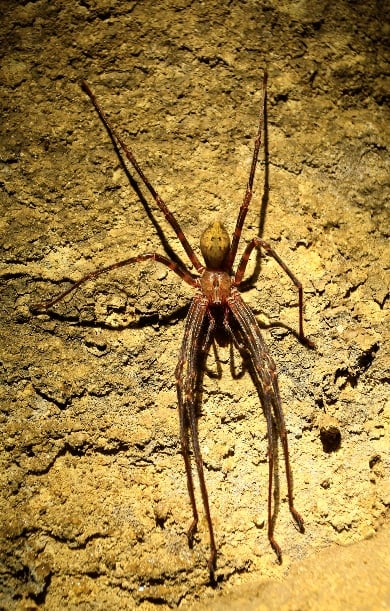200 m return via same track
Crazy Paving Cave is closed to protect the rare spiders which live in it.
Box Canyon and Crazy Paving Caves are both on the same short track. These caves are etched into 35-million-year-old limestone sandwiched between blue-grey mudstone and a bed of 350m million-year-old granite. Visitors can explore the caves at their leisure without the need for a guide.
Box Canyon Cave was carved out when melting ice brought large amounts of water and debris through its chamber during the last glacial period. At that time Box Canyon had water running through up to its ceiling. As the water course changed the cave became dry and dusty as it is today. As you enter you will clearly see the reason for its name.
Crazy Paving Cave is closed to visitors until June 2023 to give its resident Nelson Cave spider population a chance to recover. This cave gets its name from dried sediment on the floor which looks like large paving stones. When water still ran through the cave sediment was brought in which slowly dried out as the water’s path changed. As the sediment has been protected from wind, water, rain, and sun for hundreds of years it provides a great time capsule for scientific study.
Both caves would have previously been connected to the wider network of caves in the area, but passages were closed off a long time ago when filled in by sediment.
Access the caves from the car park at the end of McCallums Mill Road, north of Karamea. From Karamea, head north for about 10 km, then turn into McCallums Mill Road and follow this for 15 km to the end.
Note, McCallums Mill Road is a narrow and steep gravel road. It is not suitable for large vehicles or campervans.
Remember to take a torch. It is essential for exploring the small but fascinating caves.
The Ōparara basin is home to many species of cave invertebrates.

Nelson Cave Spider
The Nelson Cave Spider Spelungula cavernicola is New Zealand’s largest native spider with a leg span of up to 13cm. So far it has only been found in Ōparara /Lower Heaphy, and Golden Bay though there is hope it may be found in other areas.
Although Spelungula is strongly associated with caves, it is not a truly cave adapted species as it still has functional eyes, ‘normal’ pigmentation and its egg sacs are often above overhangs where subdued daylight can reach. This means the species is considered a troglophile as opposed to a troglobite. Troglophiles are animals who spend part or all of their lives in a cave. They differ from troglobites in that they have not adapted to permanent life in a cave.
The New Zealand glowworm is another example of a well-known cave loving species widely found outside caves. Spelungula have yet to be found outside caves, but it may be possible. If you see any large spiders outside on your visit upload a picture to inaturalist.org which may help to confirm if they are outside.
Spelungula is one of three members of the Gradungula family found only in NZ and Australia. Family members are known as the large-clawed spiders due to the enlarged claws on the first and second legs which can be used to pierce and hold prey. The other family members are the Piano Flat Spider Pianoa isolata, which appears to be restricted to Waikaia Bush and Piano Flat, and Sorenson’s spider Gradungula Sorenson widely distributed throughout West Coast forests.
The Ōparara caves are home to a wide range of other species. This includes cave beetles such as Kettlotrechus pluto and Pholeodytes Cerberus only known to be found in Ōparara karst. Unlike Spelungula these beetles are eyeless and rely on other senses to get around. Harvestmen are present too as are many yet to be described crustaceans such as amphipods and isopods, weta and many snails. Make sure to respect any lifeforms you encounter in these caves.
Paparoa National Park Visitor Centre
| Phone: | +64 3 731 1895 |
| Email: | paparoavc@doc.govt.nz |
| Address: | 4294 Coast Road Punakaiki RD 1 Runanga 7873 |
| Hours: | Visitor centre hours and services |
